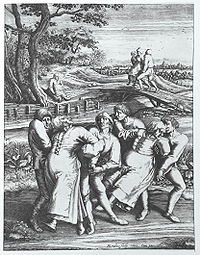Dancing Plague Of 1518


The dancing plague (or dance epidemic) of 1518 was a case of dancing mania that occurred in Strasbourg, Alsace (now modern-day France), in the Holy Roman Empire in July 1518. Somewhere between 50 and 400 people took to dancing for days.
Events
The outbreak began in July 1518 when a woman began to dance fervently in a street in Strasbourg.
Historical documents, including "physician notes, cathedral sermons, local and regional chronicles, and even notes issued by the Strasbourg city council" are clear that the victims danced. It is not known why.
Historical sources agree that there was an outbreak of dancing after a single woman started dancing, a group of mostly young women joined in, and the dancing did not seem to die down. It lasted for such a long time that it attracted the attention of the Strasbourg magistrate and bishop, and some number of doctors ultimately intervened, putting the afflicted in a hospital.
Controversy
Controversy exists over whether people ultimately danced to their deaths.
Some sources claim that, for a period, the plague killed around fifteen people per day; however, the sources of the city of Strasbourg at the time of the events did not mention the number of deaths, or even if there were fatalities. There do not appear to be any sources contemporaneous to the events that make note of any fatalities.
The main source for this claim comes from John Waller, who has written several journal articles on the subject and the book A Time to Dance, a Time to Die: The Extraordinary Story of the Dancing Plague of 1518. The sources cited by Waller that mention deaths were all from later retellings of the events. There is also uncertainty around the identity of the initial dancer (either an unnamed woman or "Frau Troffea") and the number of dancers involved (somewhere between 50 and 400).
Modern theories
Food poisoning
Some believe the dancing could have been brought on by food poisoning caused by the toxic and psychoactive chemical products of ergot fungi, which grows commonly on grains (such as rye) used for baking bread. Ergotamine is the main psychoactive product of ergot fungi; it is structurally related to the drug lysergic acid diethylamide (LSD-25) and is the substance from which LSD-25 was originally synthesized. The same fungus has also been implicated in other major historical anomalies, including the Salem witch trials, although ergot alone would not cause unusual behavior or hallucinations except when combined with opiates.
However, John Waller in The Lancet argues that "this theory does not seem tenable, since it is unlikely that those poisoned by ergot could have danced for days at a time. Nor would so many people have reacted to its psychotropic chemicals in the same way. The ergotism theory also fails to explain why virtually every outbreak occurred somewhere along the Rhine and Moselle rivers, areas linked by water but with quite different climates and crops".
Stress-induced mass hysteria
This could have been a florid example of psychogenic movement disorder happening in mass hysteria or mass psychogenic illness, which involves many individuals suddenly exhibiting the same bizarre behavior. The behavior spreads rapidly and broadly in an epidemic pattern. This kind of comportment could have been caused by elevated levels of psychological stress, caused by the ruthless years (even by the rough standards of the early modern period) the people of Alsace were suffering.
Waller speculates that the dancing was "stress-induced psychosis" on a mass level, since the region where the people danced was riddled with starvation and disease, and the inhabitants tended to be superstitious. Seven other cases of dancing plague were reported in the same region during the medieval era.
This psychogenic illness could have created a chorea (from the Greek khoreia meaning "to dance"), a situation comprising random and intricate unintentional movements that flit from body part to body part. Diverse choreas (St. Vitus' dance, St. John's dance, tarantism) were labeled in the Middle Ages referring to the independent epidemics of "dancing mania" that happened in central Europe, particularly at the time of the plague.
See also
- Sydenham's chorea
- Tanganyika laughter epidemic